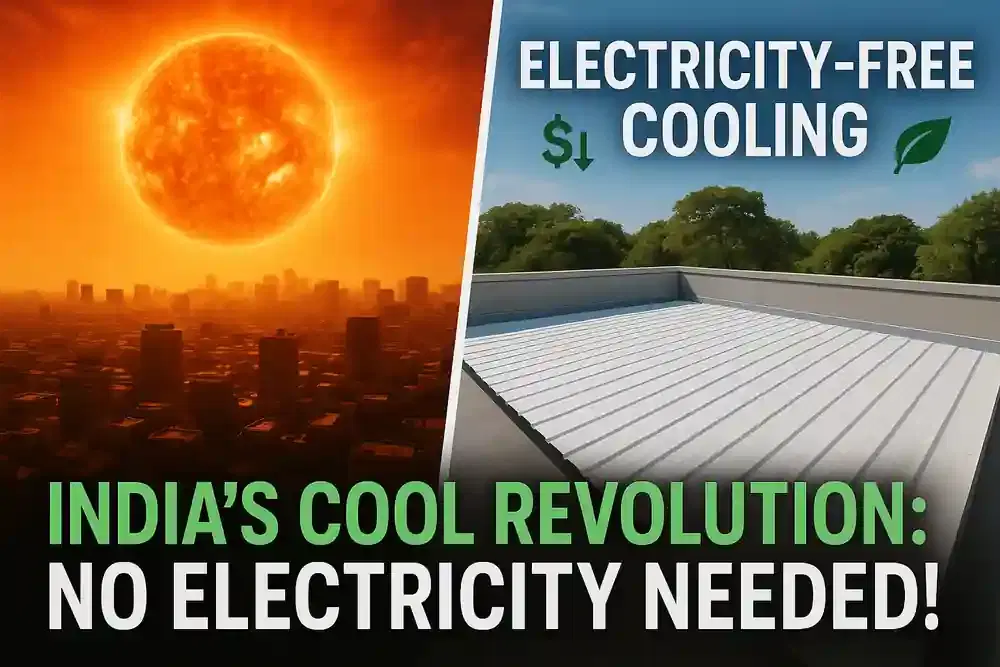India's Breakthrough: Electricity-Free Cooling Technology to Combat Heatwaves and Grid Strain
Environment
|
29th October 2025, 12:38 PM

▶
Short Description :
Detailed Coverage :
India Faces Growing Cooling Demand and Grid Pressure India's summers bring record heat, significantly boosting electricity consumption and raising the risk of widespread power grid blackouts. Cooling, once a luxury, is now essential, with the International Energy Agency projecting India's cooling demand to grow nearly eightfold by 2038, potentially accounting for 45% of peak electricity load in some regions. This escalating reliance on air conditioning places immense pressure on the power grid.
The Rise of Electricity-Free Cooling A promising solution is emerging through clean technology: electricity-free cooling. This innovative method bypasses energy-intensive compressors and refrigerants, instead using passive reflective coatings. These special coatings deflect solar radiation and release heat, effectively lowering surface and indoor temperatures without consuming any electricity.
How the Technology Works When applied to rooftops, walls, or glass surfaces, the coating prevents heat absorption, thereby reducing the need for conventional air conditioning. This directly translates to lower electricity bills for consumers and a decrease in carbon emissions. The technology offers an attractive return on investment, estimated within three years, presenting both environmental and economic advantages.
A Scalable Solution for India Given India's vast and expanding construction sector, this innovation is highly relevant. The coatings can be applied to existing buildings without substantial structural modifications, making it accessible for industries, hospitals, and housing developers. As India continues to build millions of square metres of new space annually, adopting electricity-free cooling can yield significant national energy savings.
Successful Trials and Potential Impact Leading Hospitality Services, in partnership with Hong Kong-based i2Cool, has conducted trials in commercial and healthcare settings. These trials demonstrated that nanoparticle-based coatings could reduce surface temperatures by up to 20°C and achieve 20–25% savings in electricity usage. This technology offers a practical way to alleviate grid pressure and make thermal comfort accessible to more people.
A Billion-Dollar Opportunity Experts see this innovation as a major growth area within India's green technology sector. The local manufacturing of reflective materials, installation services, and monitoring systems could foster a new industry valued at over a billion dollars. Widespread adoption could be crucial in preventing power shortages during peak summer months and reducing the frequency of blackouts.
Path Towards Climate Resilience With heatwaves becoming more frequent, the demand for sustainable and affordable cooling solutions is critical. Electricity-free cooling can help India navigate climate challenges while supporting its development objectives, turning buildings into catalysts for climate resilience.
Impact: This news is highly significant for the Indian stock market, potentially creating new industries, reducing energy costs for businesses, and alleviating critical infrastructure pressure. Its impact could be substantial across several sectors. Rating: 9/10
Difficult terms: Passive reflective coatings: Special materials applied to surfaces that reflect sunlight and radiate heat away, helping to keep the surface cooler without using electricity. Compressors: A mechanical device that increases the pressure on a gas, used in air conditioners to circulate refrigerant. Solar radiation: Energy emitted from the sun in the form of electromagnetic waves. Carbon emissions: The release of carbon dioxide and other greenhouse gases into the atmosphere, primarily from burning fossil fuels, which contribute to climate change. ROI (Return on Investment): A financial metric that measures the profitability of an investment relative to its cost. Nanoparticles: Extremely small particles, usually measured in billionths of a meter, that have unique properties due to their size.